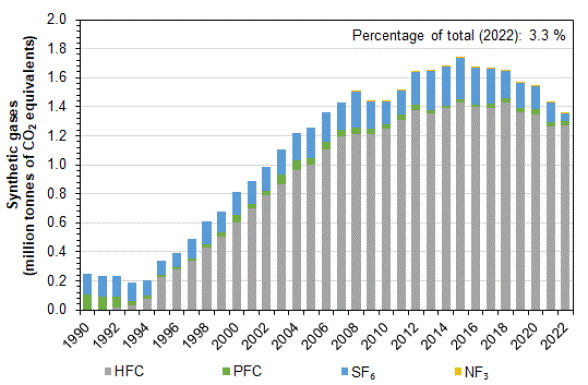Emissions of artificially manufactured gases contribute (in some cases substantially) to the greenhouse effect. These synthetic gases are used as coolants in cold-storage rooms, refrigerators and air conditioning systems, as electrical insulators and as solvents, as well as in the production of foam materials. Thereby, unintended emissions into the atmosphere occur.
Synthetic gases include hydrofluorocarbons (HFC), perfluorocarbons (PFC), sulphur hexafluoride (SF6) and nitrogen trifluoride (NF3). Their impact on the greenhouse effect exceeds that of carbon dioxide (CO2) many times over in some cases, so even low emissions of synthetic gases are important. The sharp increase since 1994 is primarily due to the replacement of chlorofluorocarbons (CFC) with HFC. CFCs deplete the ozone layer and are powerful greenhouse gases. However, they were omitted from the Kyoto Protocol as they were already regulated in the Montreal Protocol (a ban on the use of CFCs in order to protect the ozone layer).

Further information
Documents
Kenngrössen zur Entwicklung der Treibhausgasemissionen in der Schweiz (1990-2022) (PDF, 1 MB, 15.04.2024)Stand April 2024 (in German, also available in French)
Data
Emissionsübersicht: Tabellen zum Bericht (Version April 2024) (XLSX, 350 kB, 15.04.2024)Tabellen zum Bericht «Emissionen von Treibhausgasen nach CO2-Gesetz und Übereinkommen von Paris» (in German, also available in French)
Last modification 15.04.2024





